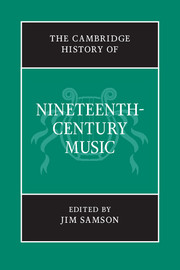Book contents
- Frontmatter
- Part One 1800–1850
- Part Two 1850–1900
- 11 Progress, modernity and the concept of an avant-garde
- 12 Music as ideal: the aesthetics of autonomy
- 13 The structures of musical life
- 14 Opera and music drama
- 15 Beethoven reception: the symphonic tradition
- 16 Words and music in Germany and France
- 17 Chamber music and piano
- 18 Choral culture and the regeneration of the organ
- 19 Music and social class
- 20 Nations and nationalism
- 21 Styles and languages around the turn of the century
- Chronology
- Institutions
- Personalia
- Index
- References
18 - Choral culture and the regeneration of the organ
from Part Two - 1850–1900
Published online by Cambridge University Press: 28 March 2008
- Frontmatter
- Part One 1800–1850
- Part Two 1850–1900
- 11 Progress, modernity and the concept of an avant-garde
- 12 Music as ideal: the aesthetics of autonomy
- 13 The structures of musical life
- 14 Opera and music drama
- 15 Beethoven reception: the symphonic tradition
- 16 Words and music in Germany and France
- 17 Chamber music and piano
- 18 Choral culture and the regeneration of the organ
- 19 Music and social class
- 20 Nations and nationalism
- 21 Styles and languages around the turn of the century
- Chronology
- Institutions
- Personalia
- Index
- References
Summary
Most historical accounts of European choral movements in the nineteenth century note a certain loss of intensity and idealistic purpose after the revolutions of 1848. Central to the constellation of possible reasons may be the expansion and liberalisation of economies leading to greater mass production and an increasing division of labour. With an enormous growth in musical consumption and participation in massed singing a dilution in the idealistic zeal displayed by the first amateur choral groups was all but inevitable. The changes in musical production were equally predictable with an increasing distinction between the amateur and the professional that may have resulted in some decline in the musical capabilities of the former. Dahlhaus relates the withering of the seemingly holistic combination of conviviality, educative purpose and bourgeois self-display to the increasing polarisation of the public and private spheres; audiences became an anonymous, cosmopolitan public who no longer fully shared the social brotherhood of the amateur singers. Steady economic growth contributed to a sense of hedonism rather than idealism in some places, such as Napoleon III’s France, but also to more authoritarian, centralizing regimes. It was not unknown for choral establishments to be subject to police observation and many inevitably swapped their idealism for a more reactionary stance. On the other hand, the very fact that some musical institutions provoked official surveillance suggests that they must have retained some of their radical elements.
- Type
- Chapter
- Information
- The Cambridge History of Nineteenth-Century Music , pp. 522 - 543Publisher: Cambridge University PressPrint publication year: 2001
References
- 1
- Cited by

